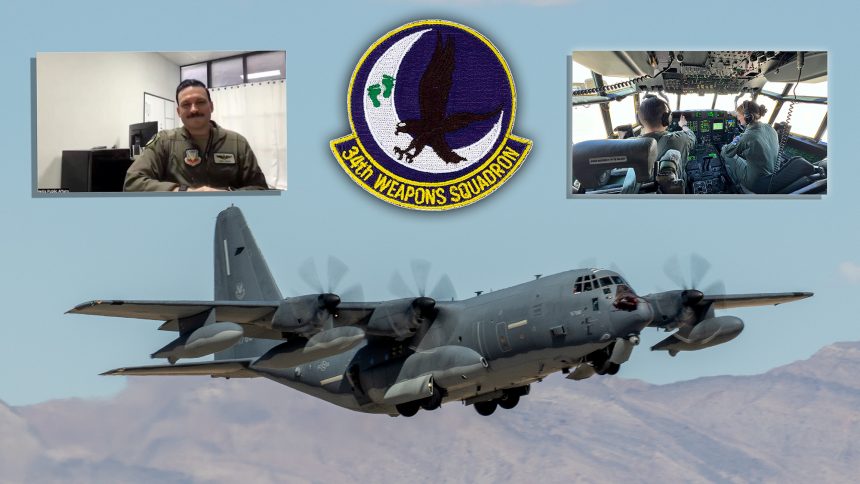Everything you’ve always wanted to ask an HC-130J Combat King II pilot but never had the courage to: conversation with an Instructor Pilot at Nellis Air Force Base.
As you may have noticed if you follow The Aviationist‘s social media channels, a couple of months ago, this Author, thanks to the collaboration and support of the 57th Wing, had the chance to visit Nellis Air Force Base, Nevada. Among all the other things, during the visit, we spent time at the 34th Weapons Squadron of the USAF Weapons School, one of the few multi-MDS (Mission Design Series) units in the Air Force, operating two distinct aircraft types: the HC-130J Combat King II , based off the KC-130J and modified with improved navigation, threat detection and countermeasures systems, as well as the ability to conduct Helicopter Air-to-Air Refueling (HAAR) using two underwing pods which allow the refueling of two helicopters at the same time both, during day and night; and the new HH-60W Jolly Green II.
I also met some of the squadron’s Instructor Pilots and also got up close and personal with the aircrews of one of an HC-130J Combat King II as they prepared to launch on a mission inside the NTTR (Nevada Test and Training Range).

The most memorable part of the visit came a few weeks after my time “physically” at Nellis, when I had the chance to connect with Maj. Kevin Rivera, an Instructor Pilot with the 34th Weapons Squadron, who flies the HC-130J Combat King II, the Air Force’s only dedicated fixed-wing platform for Personnel Recovery missions, during a lengthy Zoom interview. Here below, you can find the full set of questions and answers from our interview. You will also be able to watch the complete interview on our Youtube channel in the next few days.
Question: Maj. Rivera can tell us a bit more about yourself, your background and your experience?
Answer: Yeah, absolutely. So let’s just start where I joined the Air Force. I joined the Air Force in 2005, in July of 2005. I was enlisted as a bio-environmental engineering technician. I did a few assignments with that and then I was part of a unique group called the Air Force Radiation Assessment Team. We did a lot of radiological sampling during Tomodachi, the earthquake and tsunami that happened over in Japan, helping out the Japanese government and the US government with radiological surveys near Fukushima and Sendai.
Through that experience, I was able to fly on numerous aircraft. So that’s where the aviation bug really hit me. And I applied to commission through Officer Training School and received a pilot slot out of Wright-Patterson Air Force Base. So that’s where my flying career began. I flew in pilot training at Laughlin Air Force Base, T-6s and the T-1. And then, from there, went on through C-130J, the slick version of the C-130 school in Little Rock and received the mission qualification there. And from there I went to Kirtland Air Force Base for special mission training, and flew the HC-130J Combat King II in training.
First operational assignment was Moody Air Force Base with the 71st Rescue Squadron under the 23rd Wing. Did a few deployments there and then from that, I upgraded to Instructor Pilot in that assignment, applied for the Weapons School, and then PCSed to Davis Monthan Air Force Base with the 79th Rescue Squadron. Did a brief stint there, completed Weapons School in 2020, with Class 20A, and was selected to return to the Weapons School and instruct. And I’ve been there ever since for the last three years as a Weapons School Instructor Pilot and evaluator pilot with the 34th Weapons Squadron.
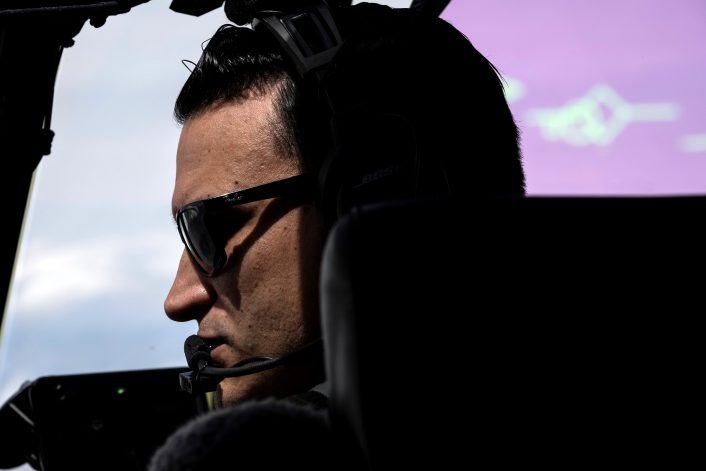
Can you tell us more about the 34th Weapons Squadron?
The 34th Weapons Squadron’s mission primarily is to produce Weapons Officers, individual experts in their mission assigned aircraft, and then also produce advanced instructors course students that’ll graduate there and be advanced instructors for loadmaster career fields and special mission aviator career fields. The 34th Weapons Squadron is unique, it’s one of the few with two mission design series, or multi MDS Squadrons, in the Air Force structure, as a whole. You have the HC-130J Combat King II, which I fly, and the HH-60W Jolly Green II. The squadron is split to produce experts in those two MDSs through an approximately five and a half month course.
What are the kinds of pilots that come through the 34th Weapons Squadron?
There’s a minimum requirement for pilots, we also have Combat Systems Operators, loadmasters and special systems aviators. All of them are instructors in their mission design series. They’re experienced and they have to be board-selected and qualified to attend the Weapons School. Typically they are the top instructors throughout the Air Force in these mission design series, or MDSs.
It also takes a unique individual to gain more knowledge and experience out of the Weapons School. And then translating that into serving as a Weapons Officer, or what we call a tier one instructor back inside the operational squadrons, applying the lessons learned here to day to day training missions that eventually distill down into operational execution in whatever theater they deploy to.
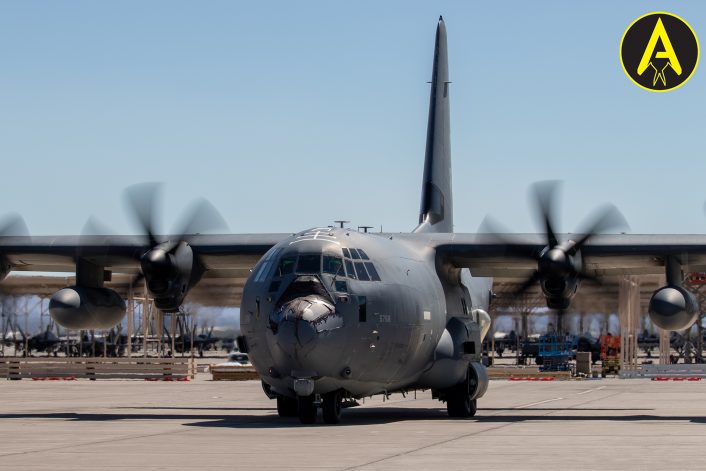
Do you deliver different types of courses at the Weapons School?
As I said, our primary mission is to produce weapons officers and AIC students, or Advanced Instructor Course students. However, on a space available and time available basis, we do provide a combat search and rescue coordinator upgrade for HC-130J pilots and Combat Systems Operators to on a space available basis, come through our combat search and rescue phase and then receive this qualification, which is a Air Combat Command certified syllabus. Additionally, on the HH-60 side, they can do some flight lead upgrade type sorties within that high intensity combat environment that we provide for them in training here at Nellis. So there are some additional opportunities within the course.
And if you have to highlight the key challenges for a pilot during the course, can you tell us a bit more about what pilots can expect from the training that is delivered there?
Yes. From the beginning, it’s different than any other Air Force course. So typically, you’re trained or instructed. You have a number of syllabus events leading up to your upgrade or qualification. A lot of things at the Weapons School are what we call experiential learning. And we also have to understand that these are already instructors, usually experienced instructors in their respective aircraft. So the Weapons School provides a training environment and a building block approach to help them become experts and Weapons Officers. And a lot of that difficulty comes in breaking down their previous instructor habits and how they analyze and dissect a normal training sortie.
What we typically would break them down to is a “how”, a “why”, a common error and an instructional fix in their instruction delivery. And then applying some sort of tactical application to all of their thoughts, or mindset, moving forward.
The next most difficult part for a lot of people, especially in the HC-130Js, is the art of the debrief. Distilling a debrief focus point, identifying contributing factors, applying instructional fixes to those, and then coming up with an overall lesson learned. Really breaking down that analysis chain so they can create either learning opportunities for their crew members in the future or get to a point where they can develop and further our tactics and employment down range. Finding new ways of doing things with, you know, airframes that have been around for 60 or 70 years and applying to emerging challenges is the goal. And I think that’s really difficult for people to come in here and place this all on their shoulders, and have the expectation to think, teach and grow through that spectrum.
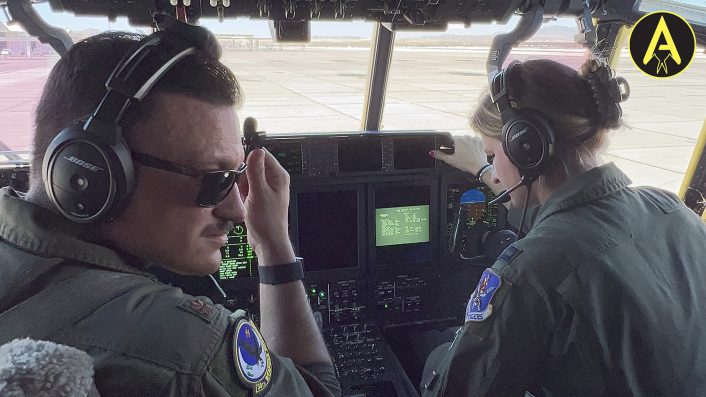
As you mentioned, now you also operate the HH-60W. This has replaced the previous the Golf variant. The introduction of the new weapon system has led to a transformation in the type of training that you deliver. What has been the change that has been caused by the new type of helicopter?
There has been some changes in terms of just outright payload, service ceiling and speed with the HH-60W. Also the integration of digital systems and crew situational awareness is a big part of what we do in both MDSs. There’s been a few small drawbacks that we didn’t really anticipate. There’s some defensive drawbacks in the loss of the DAIRCM (Distributed Aperture Infrared Countermeasure) system and then there is a loss of the ability to do some DF or drop circle for isolated personnel finding. But overall, the goal is advancement in situational awareness, and that’s what the HH-60 brings us, in the minor increase in payload capacity for the combat search and rescue mission.
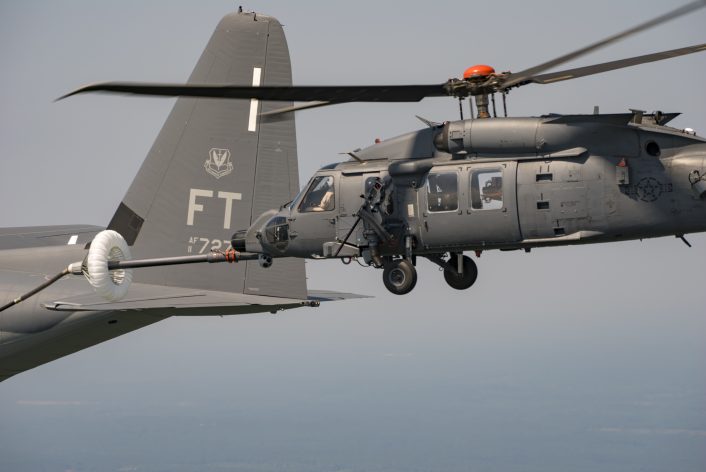
We mentioned the new type of helicopter, but also the HH-130J is an advanced variant compared to the to the previous to the previous P or N variant of HH-130: can you highlight the main differences between the two types?
I never flew the previous model, what they call a J Baby, by trade. However, I had experience showing up at Moody as a young lieutenant, and there were still a few P models on the ramp. Additionally, I’ve just heard the stories about how the HC-130J community has grown over the past eight to ten years since the J model came online for the community. What we really gained was a massive increase in situational awareness. From what I understand about the P model, many of the crew roles and responsibilities were very stovepiped or narrow: the pilot would focus on Pilot Flying duties and heads up; the Pilot Monitoring would monitor those systems. Then you had a navigator responsible for navigating the aircraft. In some cases, there was a radio operator to handle communications with outside agencies or mission-type communications. There were loadmasters in the back of the aircraft and a flight engineer. So, all these stovepiped roles led to expertise in each specific crew position and situational awareness within the airplane.
What I think the J model brought with the integrated advanced digital avionics, defensive systems and reduced crew load, is the ability to transition from having all that situational awareness in front of you and then start thinking from the aircraft out. And I think that the biggest change that we’ve seen in the HC-130 community is the ability to start to coordinate the rescue effort, understand threat a lot better, react to threat, especially on the RF spectrum, and then continue to push the aircraft and its capability closer to the combat environment within risk to be more effective.
I think that’s the biggest thing you got out of the J in terms of knowledge. And then the other ancillary pieces are the increased power associated with the J model engines, the FADEQ authority, the increased payload capacity, altitude and speed, and then short range takeoff and performance of the airplane itself on the J model.
View this post on Instagram
The J model is often used in personnel recovery. It can be used also in combat situations. How do you train student pilots to manage all the complexities of the high end and high stress scenario.
Ultimately, we’re all kind of creatures of habit. So, in the aircrew realm, there’s typically breakdown to a phase-based approach, and then checklists. Because I think if you chunk everything down that happens in a combat search and rescue into phases, you follow checklists through it, and then you apply experience to it, it distills and comes out as sort of an ethos, if you will. So what we do is, when we have the students come through the course in the HC-130, it’s kind of a ground-up approach. The beginning of the Weapons School phase for them, the aircraft maneuvering phase, is all about max performing the aircraft in the low altitude environment, and then understanding effective use of terrain masking and the aircraft performance and reaction to that perceived threat. Then from there, we take them on to a defensive tactics phase, where we layer in threats on the RF spectrum, and a heavy focus on that to understand what happens with the RWR. And then from there, they can apply that rationale of threat avoidance, just good bread and butter, low altitude tactics, direct terrain masking, and they start to understand the mindset of tactical employment assets such as the A-10 or the HH-60, and how they push towards a terminal area.
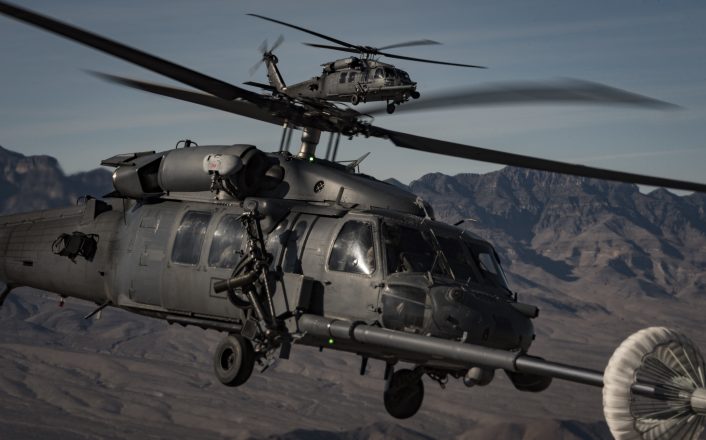
The next portion would be applying the crew concepts, the communication and brevity required to execute a tactical event. So for us, it’d be like an airdrop, a helicopter refueling, an assault landing on a dirt strip or something along those lines. So now you kind of understand threat, good low altitude flying, and then you execute that mission. So, you’re starting to build up experience and understanding how an entire stack of assets would work together with their capabilities in a defined area of airspace in relation to a barrier, such as a threat. And then, which we’re going to start next week, is the combat search and rescue phase. You start focusing in on the isolated personnel, their unique emissions signature that you can collect and how to increase the survivability of the isolated personnel, while understanding that mental model throughout the whole package and making the time sensitive execution happen in relation to the execution of the enemy or the threat to getting to the isolated personnel, or the threats to the package.
And I think that’s what we all try to put together and put into the mindset of the instructors that come out here. And the biggest difference here is that we have the feedback loop for the threat. And we have the feedback loop of the training, the tools that we use, such as recording the flights, the flight parameters, the radar, the RWR, the audio of the crew, and doing full debriefs with three dimensional GPS trails. Getting that feedback loop really helps them understand how to avoid the threat and why time is so critical in a combat search and rescue environment.
During my visit at Nellis Air Force Base, I had the opportunity to see you preparing and launching a mission. Can you share with us a bit more about that specific mission or what you were doing, which phase of the training was that one, and so on?
That was in the heart of our defensive tactics phase, and it was a Surface to Air threat sortie. What we do is we take the students from a legacy surface to air missile threat, defensive missile order of battle, and then we increase the fidelity and level of threat as the sorties move on in the phase. So, in the beginning, we might present them with an environment that has SA-2, -3, -6, -8, some of those legacy SAMs, because then, in training and in briefing, they can start to learn and understand threat basics, and then apply the defensive capabilities of the HC-130 against those and then execute those in a sortie over in the NTTR, the Nellis Test and Training Range, because of the emitters that it has the capability to replicate.
So we take it from that level: they learn some of the basics, apply the TTP or Tactics, Techniques, Procedures, against those, and then we land. We get a feedback loop from the modeling and simulation capabilities that we have here. From that point forward, we increase the capability of the threat, so we use DMOBS, or Defensive Missile Order Battles, from later or more advanced SAMs, so -11, 1-7, -15, -26. So they can start to learn that and apply what they read, apply weaknesses and strengths, weaknesses of the system, against strengths of our platform, and then execute those downrange a debrief to them.
So what we’re going to go do is fly a surface air threat sortie against SA-15s and whatever we can replicate, either by using factor ranges or TAC plots or flying against joint training emitters within the confines of the range and coming back and debriefing to those in a low environment.
View this post on Instagram
How do you perceive the role of the HC-130J weapons instruction course evolving? Is there any area that you believe still need an improvement? Because I think this is quite dynamic. Things may change based on the feedback, based on your experience, and also the current scenarios where the US Air Force is currently operating and will operate in the future.
For the future of the HC-130, what I see is—and we’ve been working on this a lot—we work closely with the A-10. The A-10 serves as the rescue mission commander and holds a rich history of operating as a ‘Sandy’ or ‘Sandy 1.’ However, the future looks somewhat limited based on current outlooks, and retirements are occurring. I’ve spent many years with those who fly and employ the A-10 at the highest level, specifically the blackboard instructor pilots of the A-10 at the 66th Weapons Squadron. Much time has been devoted to translating their expertise in the rescue mission commander role, encompassing all the tasks and phases they execute, and identifying an asset capable of managing the situational awareness needed to command and execute the rescue mission dynamically.
When I refer to a dynamic basis, I mean being pre-positioned near whatever mission is underway, whether it’s a dedicated strike mission or something similar. Being close enough to gain situational awareness and then executing with available assets in a time-sensitive manner is essential. This approach is informed by legacy studies from Southeast Asia onward regarding the time and risk associated with isolated personnel. Typically, the level of risk is time-dependent; if you can intervene within 40 minutes of an ejection and threat mitigation is possible, recovery can proceed smoothly with a rescue vehicle or helicopter in the terminal area.
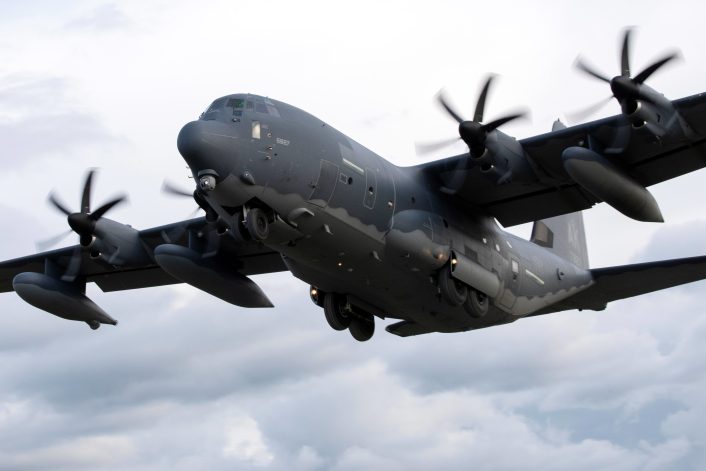
Based on the A-10 community’s knowledge and our positioning in the HC-130, the biggest advances I foresee involve increased situational awareness, especially in the terminal area. Understanding threat locations relative to isolated personnel and knowing how to mitigate those threats are key. Since we don’t have onboard capabilities for directly protecting isolated personnel as a rescue mission commander on the HC-130, we rely on mental knowledge or information gathered from other assets and situational awareness tools. It then falls to us to communicate this information to assets checking in, like an F-16 or F-15, helping them understand threat positions and how we intend to support the rescue vehicle’s entry, protection, and exit from the terminal area.
The future for HC-130 situational awareness looks promising. We are currently integrating Link 16 and will soon be operating with Link 16-equipped aircraft in our integration phase. We’ve been working to get onboard secure internet access, which will enable faster communication and coordination within the short timeline needed to recover isolated personnel. We’re also getting a software upgrade for situational awareness tools onboard, including tablets and laptops at the Combat Systems Operator (CSO) Station. This upgrade should allow us to better understand the Air Force’s common operating picture in real time, reducing the timeline and risk associated with recovery missions.
Our aim is to apply the A-10 community’s specialized knowledge to effectively execute combat search and rescue missions. Few assets have the niche capability to stay on station for extended periods, maintain situational awareness, and remain close enough to communicate with isolated personnel quickly. The HC-130 continues to hold a unique position in fulfilling this mission.
After the A-10 is retired, other aircraft will integrate into the mission and take over the Sandy role. Are you already training with them? You mentioned the F-16 and F-15; is this something that you will tackle in the future or is this already part of your training to be prepared in the near future when the [A-10] type retires?
Yeah, that’s something that we think about and work on a lot. I think the problem you run into is competing priorities with assets like the F-16 and F-15. Usually, the integration involves 10 to 15 minutes of time identifying a threat in the terminal area and then mitigating that threat, or having some sort of SEAD available for a limited period to allow the helicopters to push into the terminal area near an RF threat.
We’ve examined this from the F-16 side, but the problem is persistence. Many vulnerability periods we train in involve multiple isolated personnel scenarios. You could have five isolated personnel within a 40-mile range, or in high-end integration fights, you might see 15 to 20 isolated personnel over an hour or two. Persistence is key, along with situational awareness on board our aircraft before the fight—understanding where people are most at risk, the distance involved, the threats, and using what I call ‘sand tabling’ of the scenario.
Then, it’s about relaying all of that through what we call a Personnel Recovery Situation Update, or holding a ’15 line,’ which is our way of providing an execution brief to get that task done. Unfortunately, the F-16 doesn’t have much persistence, and there’s only one person in the cockpit. Even with a two-ship or four-ship formation, they face competing priorities like SEAD or strike duties. The Strike Eagle has better persistence, but their primary role is executing strikes in air and ground threat areas.
We’ve also worked with the F-35, but they often operate farther forward than where we’re aiming to execute a CSAR mission. Then, we’ve done a lot of work with the MQ-9. What the MQ-9 provides us on the HC-130 is a sensor with the fidelity to monitor the terminal area and enough firepower to make an impact, all while having situational awareness there. This can be relayed to us as the holder of the ’15 line’ or the execution plan for the recovery vehicle to reach the terminal area.
There is going to be a capability gap when the A-10, as a dedicated rescuer and ground battle mitigation asset, eventually retires. That’s a tough challenge to solve. But the rescue community will always be committed to using what we have available to execute our mission. That’s what we’re focused on teaching here at the 34th.
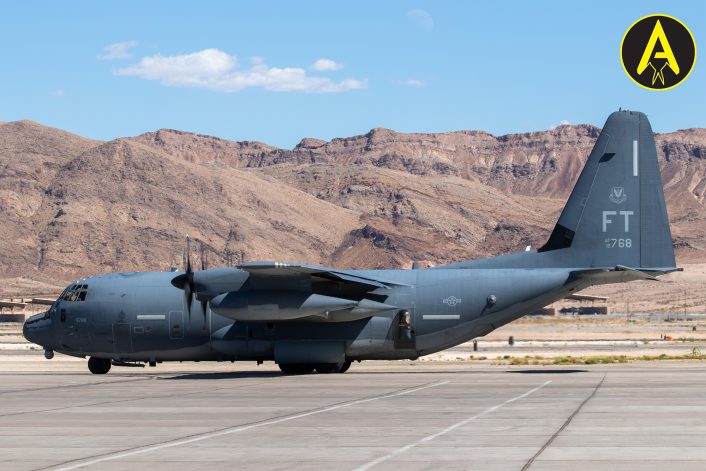
You mentioned earlier about all the types of mission that HC-130J can support. And it’s also important to support SAR (Search And Rescue) missions, personnel recovery, and also air-to-air refueling to helicopters. Can you share a bit more about the complexities of this kind of mission, the type of required training to be proficient at that and also, if you have any specific instances where the teamwork between the HH-130 and the HH-60 squadrons has made the difference also in real world scenarios, in real combat.
For the HC-130 community, I think what interests or brings a lot of our crew into the platform is that we execute on a wide spectrum of operations. So, ultimately it is a C-130, so we can do normal air drops, heavy equipment, CDS, those are different types of air drops, through a lot of environments. So I’ve seen crews in the HC-130, do the air drops in vicinity of the Gaza Strip, for instance. Just what I call bread and butter C-130 stuff on a dynamic nature.
And then you get the next portion, the helicopter refueling aspect. So the HC-130 actually can refuel, not just the HH-60, but almost anything that’s equipped with a probe on a coalition level too. So I’ve refueled Harriers, MV-22s, CV-22s, marine helicopters, etc. And what that really buys you is the ability to bring an asset that’s not necessarily persistent closer to the fight. And that’s what the C-130 does, in terms of the whole penetrating tanker that you may have heard in the past, or what you may have seen in Afghanistan. It’s the ability to bring the HH-60, or whatever asset in a more denied environment or contested denied environment than your traditional tankers.
Because you have robust defensive capability, redundancy in the platform, and the ability to fly low level and understand the threat as you get there. Which I’ve executed for real world missions and in vicinity of a high value target takedown in some sort of urban area that’s over a great tyranny of distance. So you have to provide the fuel to get the lift platform for the entity. So if that’s the HH-60 or that’s another type of helicopter that we work with in the spectrum of operations with special operations forces, etc. It’s the ability to bring that asset closer to the fight and have them be available for a longer period of time, whether it’s through a forward area, refueling in rearming point, by doing a dirt landing somewhere, or holding what we call an airborne alert pattern, and then having that asset fly to us, back to the terminal area or the objective area and back, providing that effect.
So, in real missions, I’ve seen that happen to great effect, where the HC-130 and HH-60 would be offset in a hold together for a CASEVAC (casualty evacuation) or MEDEVAC (medical evacuation) type scenario, where we have dedicated landing sites and the ability to to bring or drag a helicopter great distances to bring an injured individual to a higher level of care facility.
Or I’ve also seen it to where we can land on dirt strips at night with no markings on the HC-130 and then have a more rapid means of transit or transload for that survivor to receive higher level of care. I’ve seen crews execute that mission a few times in my career and that’s in combat. We’ll do the same type of partnership or relationship here in a civil environment. So the hurricane that just passed through the Florida Panhandle [on Sept. 27, 2024].
I’ve worked on hurricane or post hurricane type missions in the past where we do a similar thing. We just pick up a hold near whatever state or city that’s affected, and we have enough gas that the HH-60 can come back and just basically treat us like an airborne gas station and then find individuals through coordination. So we’ll carry basically a Google map on the plane, we’ll get an address for an individual that’s on the roof of their house, and we’ll send those coordinates to the HH-60 crews as they refuel so we have a point of common contact there. And then they can fly, pick that individual up, take them to a safer location and continue to execute the rescue mission. It really is a beautiful relationship.
I wanted to learn from you, as an instructor pilot, if there are specific skills or attributes you believe are important for piloting the HC-130J variant of the C-130 in this mission type. Are there particular skills unique to this version of the C-130 that you think are crucial for successfully carrying out this type of mission?
I’d say flexibility is key. The HC-130 mission, specifically combat search and rescue, is dynamic in nature. We work with a wide variety of agencies and expectations, so flexibility is essential. A key example of that was when, as an aircraft commander, I was flying a mission over the Caribbean near the Bahamas. We were tasked with identifying and intercepting panga boats—drug-running boats from Venezuela or South America headed to the U.S. It was essentially a peacetime U.S. Defense mission. I was integrated with the JSTARS, which would detect radar targets and communicate them back to an operations center for us to track.
In the middle of that mission, we received a notification through a system called HPW, or High Performance Waveform, which allows data to be passed back and forth via Microsoft Outlook emails. We received an email that a tour bus carrying cruise ship passengers had overturned near Rock Sound, off the Bahamas. Three individuals were in critical condition, and another was seriously injured. They needed immediate transport to a high-level care facility back in the U.S., but local resources couldn’t transport all the patients to the main Bahamas airport for a private jet transfer to Fort Lauderdale.
We received a location and quickly changed our mission and mindset from using our electro-optical infrared sensor to identify boats to landing on an austere airstrip with minimal information. We didn’t have our standard “giant report” that provides data on landing surfaces or airport facilities. All we knew was that there were U.S. citizens critically injured who needed urgent assistance.
So, we transitioned the crew’s mindset from ISR (intelligence, surveillance, and reconnaissance) to performing an assault landing on an unknown field to evacuate injured personnel. That flexibility is incredibly important, and the tools on the HC-130 enable it. We have an electro-optical infrared sensor and the added capability of a Combat Systems Operator (CSO) on board, who can back up the pilots with navigation, handle communications on the laptop or HPW, and manage the mission—another big advantage of the HC-130.
In this case, we conducted a low pass to check out the landing surface, which looked similar or better than some austere landings I’d done in places like Africa, so I felt comfortable. We landed successfully and transported the injured individuals as quickly as possible to Fort Lauderdale, where they received care in time to save the critically injured patients with internal bleeding. Overall, I’d say that the HC-130 is involved in so many diverse missions that flexibility and a dynamic approach are absolutely essential to executing them effectively.
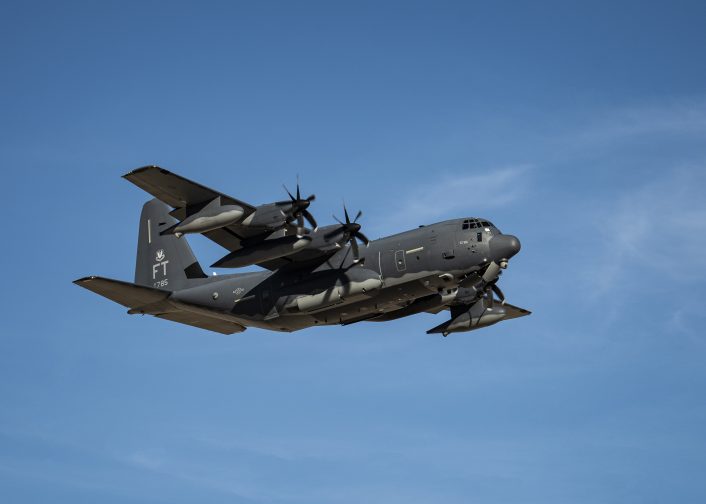
You already mentioned this, but can you briefly recap which are the crew members on the HC-130J and what tasks they carry out to when aboard the aircraft?
A combat crew consists of two pilots—a pilot and a co-pilot—and the positions on the cockpit, or flight deck, are interchangeable, so either can fly from either seat. The general duties are for the pilot flying to maintain aircraft heading, airspeed, and altitude parameters, as well as being responsible for situational awareness of the aircraft’s position in relation to threats or just general flight conditions. The pilot monitoring is responsible for communications, handling air traffic control, outside agencies, and providing heads-up support to the pilot flying, especially in low-altitude environments. This becomes crucial at night on night vision goggles with low illumination in mountainous areas.
The third crew member on the flight deck is the Combat Systems Operator. This role used to be a navigator, but much of that is now managed through FMS digital displays, making navigation relatively simple on the HC-130. However, navigation becomes more complex in scenarios such as night, low-level flights, using the radar altimeter and low-power color radar to detect terrain and plot a path. Here, the Combat Systems Operator functions more like a traditional navigator. We follow a sort of cadence or script, where the Combat Systems Operator interprets the radar scope, directs the pilot’s attention to critical obstacles or terrain, and helps guide us through a modified contour low-level flight with altitudes as low as 500 feet AGL, or around 300 feet AGL or less for threat penetration. This is where the Combat Systems Operator is especially vital during night missions.
Additionally, the Combat Systems Operator manages the refueling hoses, fuel panel with multiple tanks, and serves as the focal point for the aircraft’s defensive systems. This includes overseeing the missile warning system, radar warning system, LAIRCM (Large Aircraft Infrared Countermeasure), and expendables such as flares and chaff. They ensure that the crew uses correct terminology to communicate the threat location, the best aircraft positioning to counter it, and the proper expendable timing.
The Combat Systems Operator also supports situational awareness and communications upgrades in the aircraft, such as DataLink, with upcoming upgrades to Link 16. This integrates information into a moving map display on tablets and laptops, facilitates communication with external assets, and brings in situational awareness from over-the-horizon assets to aid in threat mitigation. They also handle SATCOM radios and the High Performance Waveform (HPW) for data exchange, allowing us to send Outlook emails directly from the aircraft. Their role centers on situational awareness, threat identification, and navigation.
All roles in the cockpit are cross-functional. Most of the switches and functionalities are redundant, so if I, for example, see an RWR indication, I can call a threat and deploy chaff myself. I have access to the tablets, which allow input via a keyboard if needed, enabling communication through DataLink or HPW.
In addition to the cockpit crew, we have two loadmasters in the back of the aircraft—typically an experienced loadmaster and a less experienced one. They are responsible for configuring the cargo, setting up the aircraft for different types of airdrops, transloads, and onloading of equipment and personnel. Here at the Weapons School, we also train them on situational awareness and communication upgrades. There’s a laptop in the back of the plane, and they can plug in a CAT5 cable to enhance mission management from the rear of the aircraft.
For instance, during a high-end integration mission, they can track the timing of an F-35 weapons engagement against an RF SAM, like an SA-15, near an isolated personnel at the last point of terrain masking. They time this engagement so that HH-60s or A-10s can enter the terminal area for a brief period while the threat is suppressed, then exit. The loadmaster can gather all this data from their laptop, just by monitoring the frequency, and pass it through the pilot or co-pilot to the A-10 mission commander or an HH-60 flight lead, without needing direct communication with the F-35, which might be unaware it’s involved in the rescue mission.
You mentioned a lot of systems that you have in the aircraft. Is there anything that you would like to add if you had the opportunity? It’s something that you said: “Okay, if I had that sensor or that thing, that would be great!”
Yes, absolutely. There’s a long list of needs. The community is really pushing to obtain a lot of that, so this is going to be a long answer. It goes back to the old P-model mindset with the previous airplane. Much of that thinking was centered around being a good tanking platform or tanker. Many individuals with that experience have moved into higher positions within the Air Force structure, and they understand that role well because that was the capability they knew at the time. But times have changed significantly, as they always do, and things evolve. So the challenge now is in communicating all the requirements and capabilities we want for this platform to those who may not have had these experiences themselves.
If I could make changes, I’d start with Link 16, which we’re getting soon. With full functionality, it provides reliable digital communication and a common operational picture for situations like those I mentioned earlier. That way, I can understand where all the threats are being identified by the 15 to 20 F-35s in the area or gather intelligence from entities like AWACS, the RQ-4, or the RC-135. Having that picture would shorten the timeline for executing rescues, such as picking up someone shot down behind enemy lines.
So, Link 16 would be the first priority. Next would be an integrated operational picture within the aircraft. We had a plan for this in the form of a 2.0 upgrade, which would integrate functionality from tablets and laptops into the aircraft structure. Though it would still be federated, we’d have a three-terabyte network-attached server managing the information flow. From there, onboard SIPRNet connectivity would unlock critical communications, chat capabilities, and over-the-horizon communication options with isolated personnel, significantly reducing the timeline to the pickup point. These situational awareness tools would greatly enhance the platform.
Additionally, I don’t know if you noticed, but the HC-130 has SABIR (Special Airborne Mission Installation & Response) Airdyne bubble doors on the paratroop doors. These can accommodate a SABIR arm, which would connect to the aircraft side, allowing us to use a podded solution, like an agile pod. For instance, in class 21A, we equipped a Lightning Pod on the aircraft, which enabled laser designation of targets and the identification of points of interest from a standoff distance. This capability allows us to rapidly direct an asset with limited on-station time to affect or shape the environment for the recovery vehicle, as demonstrated with the Lightning Pod in 21A WSINT (Weapons School Integration).
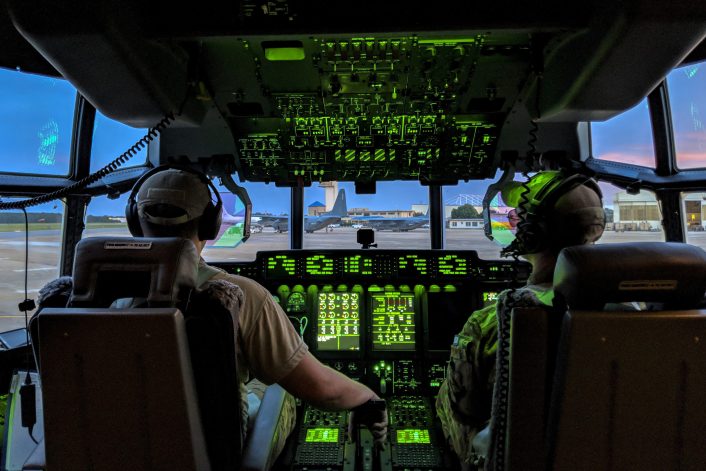
The next priority would be a SAR (Synthetic Aperture Radar) map capability. This doesn’t have to be highly sophisticated, but it would fill a significant gap in terminal area situational awareness for the HC-130. Our EOIR (Electro-Optical/Infrared) has limited fidelity from a distance, effective only from about three to five miles and at 3,000 to 5,000 feet. The SAR map capability would enable us to detect moving threats near isolated personnel in the terminal area, allowing us to build a line 13 or game plan to account for those threats as the recovery vehicles execute.
There has been a lot of discussion within our community, and I’ve done personal work early in my career, on potentially weaponizing the HC-130 with existing solutions, like the Harvest Hawk or the Griffin missile. But with experience, I realized that shifting the HC community from traditional roles—airdrop, airland, helicopter refueling, and returning home—to positively identifying targets, performing collateral damage assessments, and engaging threats is a difficult mental model to adjust. The Marine Corps has a more flexible model, with NFOs or pilots taking on various roles on platforms like the KC-130, but it’s quite a stretch for the HC community.
Additionally, weapons like the Griffin or Hellfire missiles have limited range, which is less effective against the pacing threats we face today. In recent years, as the community has focused more on near-peer threats, much of the conversation around capability, funding, and training has shifted. Short-range weapons aren’t as relevant in these environments since they lack the reach to counter distant threats. I’m now more in favor of situational awareness tools that let us communicate with assets that have those capabilities, using weapons like the GBU-39 to achieve the necessary effect on the point of impact.
Thank you very much. You provided a lot of interesting details and information. So my last question is: is there anything that I didn’t ask that you want to add?
There are some unique things that happen at the 34th Weapons Squadron. We have a motto: ‘It’s the best job I ever had.’ And I truly believe that. As I near the end of my career, I can honestly say that this is the highlight of it—creating those weapons officers. One of the unique things we do in the HC-130 that I’d like to highlight at the Weapons School is in the defensive tactics phase. We spend a significant amount of time doing Air-to-Air Combat maneuvering training. We conduct a lot of low-level, low-altitude employment against the 64th and 65th Aggressor Squadrons, and we use the lessons learned from those exercises to develop our tactics, techniques, and procedures. The personnel at the 34th, the cadre there, work really hard to take the lessons we’ve learned and put them into our TTP volumes, which we update regularly. A lot of that information is incorporated and used to ensure continuous learning.
We work from beyond visual range all the way to within visual range, including the guns arena, and we repeat that training because it’s critical for understanding pacing threats. The next area we focus on is continuing to push and evolve the community, pulling the ball and chain toward relevancy and the future. I’m not one to be so in love with my own platform that I think it’s the ultimate solution for the future, but I’m all about squeezing as much capability out of what we currently have in order to execute today’s mission, while understanding what we’ll need in the future to carry out those missions effectively.
An example of that is the integration phase. Often, the environments we encounter require great standoff distances to handle pacing air threats, which I’m sure you understand. This is where the U.S. Air Force, along with the coalition of joint forces, can really mitigate or compete in that environment. The HC-130 plays a big role in providing the situational awareness needed to create effects in these environments. We’ve also put a lot of work into programs like the Rapid Dragon program, which we’ve tested and attempted to execute in simulated scenarios during our vulnerability periods. I think this is another key area worth highlighting.
Overall, I’m just proud to be part of this. I’m happy to talk about our community, and I want to shed light on how fortunate some people may not even realize they are when they become an HC-130 crew member.
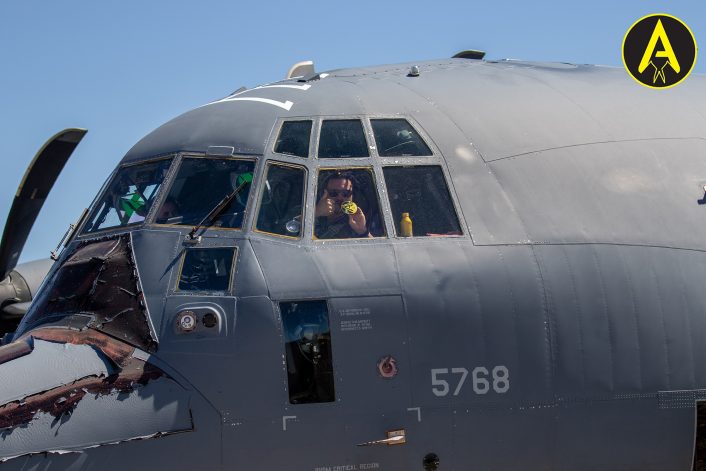
The Author would like to thank Major Kevin Rivera, the 34th Weapons Squadron (WPS), and the 57th Wing for their invaluable support before, during, and after this interview. A special thank you goes to Senior Airman Josey Blades from the 57th Wing Public Affairs for organizing the visit to Nellis Air Force Base and coordinating all related activities.

